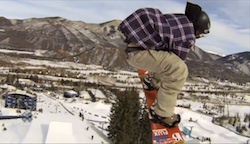
This year’s Winter X Games, ESPN’s extreme sports competition, was marred by the death of one of the competitors, 25-year-old Caleb Moore, from injuries sustained during the Snowmobile Freestyle competition in Aspen. This was the first death in 18 years of the event, which has been growing in popularity and broadcast complexity. One of the factors driving the popularity of these sort of extreme sports has been GoPro’s ubiquitous miniature cameras, which are an increasingly important part of any extreme sports participant’s kit (as evidenced by the huge number of YouTube videos), and which were out in force in Aspen, where they are now a key part of ESPN’s coverage. GoPro has signed a three-year agreement with ESPN to offer more varied views on the action – many competitors had helmet and/or chest cameras, and there were also GoPros fixed to snowmobiles and other pieces of equipment, as well as a 48-camera GoPro Array, which was used for timeslice (or bullet time) shots. This was the first time that competitors were allowed to mount cameras on their helmet during a finals event, and as gold medallists were amongst those to wear the cameras it doesn’t appear to have affected their ability to win. “GoPro has become the best selling camera in the world thanks to the passion and creativity of action sports athletes and fans across the world, so it feels fitting that, together with ESPN, we’ll be opening up a new chapter of X Games,” said GoPro Vice President of Marketing, Paul Crandell. Besides continuing with its widely viewed Course Previews from previous X Games, GoPro is also sponsoring some events, such as the Snowmobile Best Trick at Aspen and a BMX Big Air event at the X Games Los Angeles. GoPro is also producing its own content for each X Games, focusing on athlete stories and cultural narratives. It should aid ESPN’s expansion of the X Games to new countries. It is adding Munich, Barcelona and Brazil, to its traditional circuit of Aspen, Colorado; Tignes, France; and Los Angeles. It also hopes to expand X Games to include the culture, music and lifestyle of action sports. There should be a total of 130 hours of live TV coverage across the six X Games events on ESPN networks this year, which will be supplemented by coverage on digital platforms, including a year-round action sports website. Besides skiing, snowboard and snowmobiles, X Games events include BMX, skateboard, Moto X, and Rally Car Racing. Up to Pace ESPN was also transmitting the Games in 3D, using the Cameron Pace Group’s 5D (2D + 3D) production system that enables both stereoscopic and HD programming to be made using a single mobile unit, taking the HD broadcast from the ‘left eye’ of the 3D output. In Aspen it used 30 CPG 3D camera rigs, as well as 16 Sony HD (2D) cameras, including a 3D FlyCam aerial rig, and three giant 3D cranes. For slow motion, there was the first outing of CPG’s own custom 420 frames-per-second slo-mo rig, based on Vision Research’s Phantom v642, as well as a pair of I-Movix SprintCam Vvs HD cameras. There were also three wireless Followcams used by skiing cameramen to race down the hill beside the competitors on some events, as well as eight robotic cameras. As every one of its 3D rigs is now adjustable remotely, using CPG’s new Max Remote automation and convergence system (which it debuted at the Ryder Cup golf), it has been able to significantly reduce the number of crew it needs, particularly on the slopes. Among the highlights were three 3D StradaCranes (90-ft. cranes covering Big Air jump, SlopeStyle, and Snowmobile courses), a 3D FlyCam aerial camera system (for SlopeStyle course), two I-MOVIX Sprintcam Vvs ultra-slo-mo cameras, a CPG custom ultra-so-mo system (making its debut at Aspen), eight robotic cameras, and three wireless Ski Followcams (racing down the hill alongside the athletes on the Slopestyle, SuperPipe, and Big Air courses). Dynamic illumination To get power and light to the slopes, ESPN called on Illumination Dynamics, part of the Arri Group, which has been working on the X Games for 12 years. According to the company, there were “countless challenges” during the 15-day installation in turning the remote ski area on Buttermilk Mountain into a fully equipped sports venue for the live broadcasts. Its crew “endured harsh conditions” to supply 15 generators (from 60kW to 300kW – including several redundant systems), more than 22.5km of cable and multiple light fixtures at high elevations, in sub-zero temperatures, and over extremely long hours. – David Foxwww.arricsc.comwww.cameronpace.comwww.gopro.comwww.i-movix.comxgames.espn.go.com







